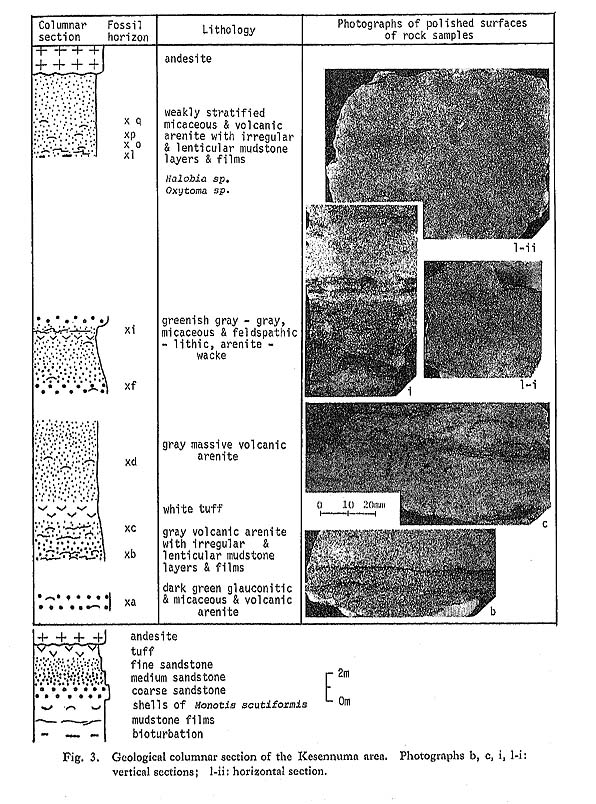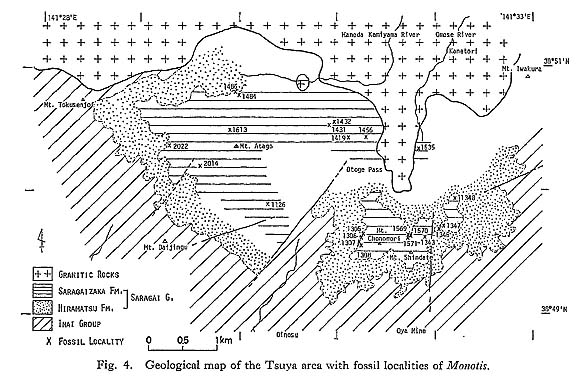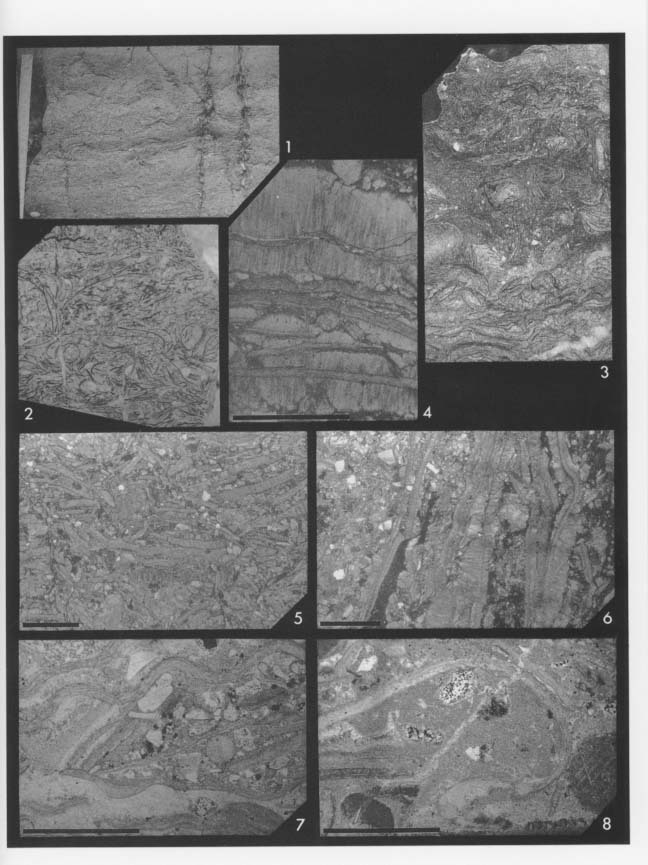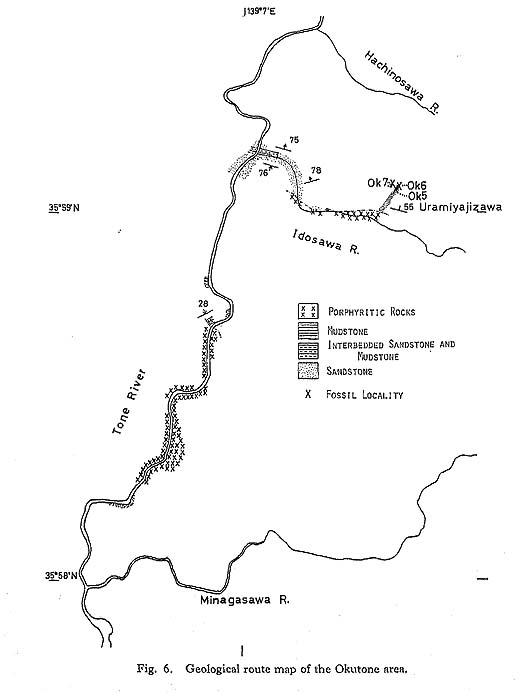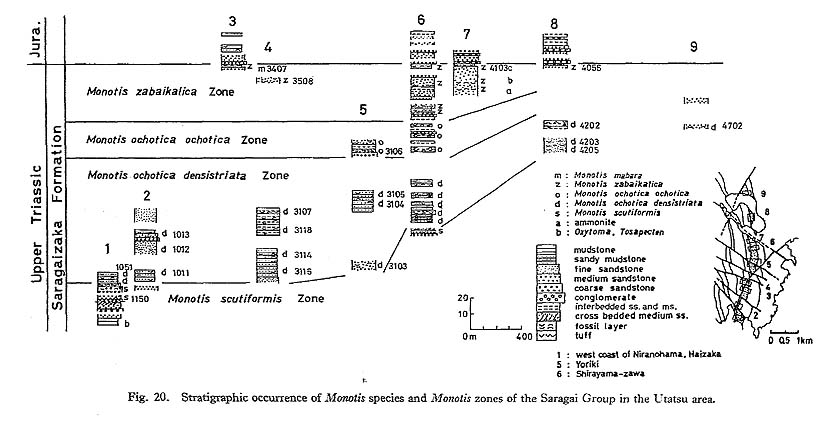CHAPTER 2
Geological Setting of Monotis-bearing Formations
1. Southern Kitakami Mountains, Northeast Japan
|
Fossiliferous Mesozoic formations, including Triassic, Jurassic and Cretaceous sediments, are distributed in the southern Kitakami Mountains, forming three synclinal belts with N-S to NE-SW trends. The distribution of the Upper Triassic Saragai Group and its correlatives is known in six areas; i.e. northward, Mizunuma, Hashiura, Utatsu, Tsuya, Kesennuma and Ofunato areas. Monotis has actually been discovered in the last four areas. In the first two areas only the lower part of the Saragai Group seems to be exposed. Because of its comparatively simple geologic structure and weak secondary deformation, the Monotis sequence is most complete and best seen in the Utatsu area. 1) Ofunato Area (Myojinmae Formation) Since Seki and Imaizumi (1941) reported the occurrence of Monotis in a boulder from an unidentified place near Ofunato, the distribution of Upper Triassic strata had not been ascertained. As described in a previous work (Kanagawa and Ando, 1983), however, several specimens of Monotis ochotica were recently discovered from tuffaceous sandstone occurring as pebbles in a volcanic conglomerate. The specimens of Monotis were obtained from a bed which had been formerly assigned to the Lower Cretaceous Funagawara Formation by Seki and Imaizumi (1941) and Onuki and Mori (1961), Kanagawa and Ando (1983) separated the Upper Triassic beds from the Lower Cretaceous formation and proposed the new name, Myojinmae Formation. The detailed lithology and stratigraphy are as follows (see also Kanagawa and Ando, 1983, fig. 2):
Funagawara Formation (Lower Cretaceous) Sandstone and mudstone Alternation of conglomerate and sandstone: conglomerate is composed of sandstone and mudstone pebbles or cobbles, lacking volcanic rocks. Myojinmae Formation (Upper Triassic) Upper member 80-20 m Reddish purple to greenish gray, volcanic conglomerate, interbedded volcanic sandstone and tuff; conglomerate mainly consists of reddish purple to greenish gray tuffaceous sand matrix and pebble- to cobble-size gravels of reddish purple to greenish gray tuff and volcanic sandstone. Lower member 20-100 m Reddish purple to greenish gray tuff; at Funagawara, the south end of the distribution, including conglomerate about a meter thick composed of sandstone, chert, mudstone gravels at the base, which is overlain by andesitic lava a few meters thick. Toyoma Formation (Upper Permian) Monotonous black shale, rarely including lenticular limestones with fusulinids. About a dozen specimens of Monotis were contained in three pebbles of greenish gray tuff and volcanic sandstone from the lower part of the upper member. Most of the gravels are lithologically similar to the lower member, suggesting that they were derived from the lower member. Those are flat in shape, indicative of paracontemporaneous deformation such as compaction just after burial. 2) Kesennuma Area (Saragaizaka Formation, Saragai Group)The Monotis-bearing formation narrowly distributed in the Kesennuma area is the northern extension of the Saragai Group, which is typically exposed in the Utatsu area. Kojima's (1960MS) first discovery of Monotis localities at Sarukake and Dohmeki in the western suburb of Kesennuma City was noted by Hayami (1961, p. 196) and Kambe and Shimazu (1961). Figure 2, a geological route map near the fossil locality, shows that a part of the Saragai Group narrowly distributed as an inlier is clino-un-conformably overlain by the Lower Cretaceous Niitsuki Formation composed of andesitic rocks. The Saragai Group is estimated to be 150 meters thick, so far as the exposed part is concerned. The lower 110 meters are massive, medium- to very coarse-grained sandstone without Monotis, The sandstone is poorly to moderately sorted, volcanic arenite or partly wacke, including abundant rhyolitic to andesitic rock fragments. The upper 40 meters sporadically yield Monotis scutiformis (Fig. 3). This portion mostly consists of fine- to medium-grained, poorly-sorted, micaceous, volcanic wacke or partly arenite with frequent intercalations of thin mud patches and films (Fig. 3b, c, i). It also contains coarsegrained sandstone beds, and white to gray tuff about a meter or less in thickness. At horizon 1, a kind of trace fossil is observed in the medium-grained sandstone (Fig. 3 l-i, ii).
Therefore, the Monotis-bearing sandstone at Kesennuma is thought to have been deposited on a shallow-sea floor with relatively weak bottom current where mud patches, films, and infaunal or epifaunal excrements could have been preserved. 3) Tsuya Area (Saragaizaka Formation, Saragai Group) Around Mt. Atago and Mt. Chonomori in the Tsuya area, the Saragai Group occurs in a synclinal basin. After the first discovery of Monotis by Kondo (1930), several investigations were carried out by Shiida (1940), Ichikawa (1951a), Onuki and Bando (1958) and Kambe and Shimazu (1961). Onuki and Bando (1958) divided the Saragai Group into two formations, namely, the lower Shindate Formation and the upper Chonomori Formation, designating their type localities in this area. Furthermore, four fossil zones, C1 to C4, were recognized in the Chonomori Formation, as in the Utatsu area. The stratigraphy is described as follows: Atagoyama Formation, Shizukawa Group (Lower Jurassic) Saragaizaka Formation (=Chonomori Formation by Onuki and Bando, 1958) 50-200m Mainly composed of coarse- to fine-grained sandstone and grayish black to dark gray mudstone, both of which often contain shells of Monotis. Near Mt. Chonomori the upper part was eroded. The thickness is about 50 to 100 meters. Near Mt. Atago a more complete sequence (more than 200 m) is exposed. Hiramatsu Formation (=Shindate Formation by Onuki and Bando, 1958) 250-300m Mainly composed of massive and sometimes weakly bedded, coarse- to medium-, and partly granule-bearing coarse-grained sandstone. The sandstone is volcanic arenite, containing many acid volcanic rock fragments. Acid tuff layers, in which a microscopic bubble wall texture can be observed, are contained in the uppermost part. Isatomae Formation, Inai Group (Middle Triassic) All of these rocks were subjected to contact metamorphism by granodiorite, especially on the: northern slope of Mt. Atago (Fig. 4). The rocks were silicified, and it is difficult to extract Monotis specimens from the mother rock. There is no good section to observe the Monotis sequence.
The extraordinarily crowded occurrence of Monotis shells observed at loc. Ch1486 in the northern slope of Mt. Atago, will be described in Chapter 4 (Pl. 1, Figs. 7-8).
4) Utatsu Area (Saragaizaka Formation, Saragai Group)The Utatsu area is the most important field for the study of Monotis as well as Triassic stratigraphy in Japan, because of the abundant occurrence of index fossils and simple geologic structure. Utatsu is the type area of the Saragaian series correlative to the Norian (Ichikawa, 1950). Since the occurrence of Monotis in Japan was first reported by Naumann (1881), geological and paleontological investigations have been carried out by Ichikawa (1951a), Bando (1964), Onuki (1969, 1981) and some others. The Saragai Group clino-unconformably overlies the Lower to Middle Triassic Inai Group, and disconformably underlies the Lower Jurassic Shizukawa Group. It is narrowly distributed along the eastern limb of the western synclinal belt mentioned previously (Fig. 5). The group was divided by Onuki and Bando (1958) into two formations, namely the Shindate Formation and the Chonomori Formation in upward sequence, whose names were derived from local names in the Tsuya area. I proposed new names for the two formations; the Hiramatsu and the Saragaizaka Formations respectively, after the local names in the type area (Ando, 1982, 1984, 1986). As an outcrop of the type locality facing Route 45 is now concealed with sprayed concrete and cannot be observed, the stratigraphy of this group is described from the sequences on the west coast of Niranohama and along a small valley, Shirayamazawa, as follows (Fig. 20):
Niranohama Formation, Shizukawa Group (Lower Jurassic) Saragaizaka Formation 100-150 m Named after the type locality, Saragaizaka along Route 45 where Naumann (1881) discovered Monotis for the first time in Japan.
Isatomae Formation, Inai Group (Middle Triassic) The abundant zonal occurrences of Monotis have been successively traced throughout the formation except the lowest part (Fig. 20). The best section showing the stratigraphic change of Monotis is found along a small valley, Shirayamazawa.
|

